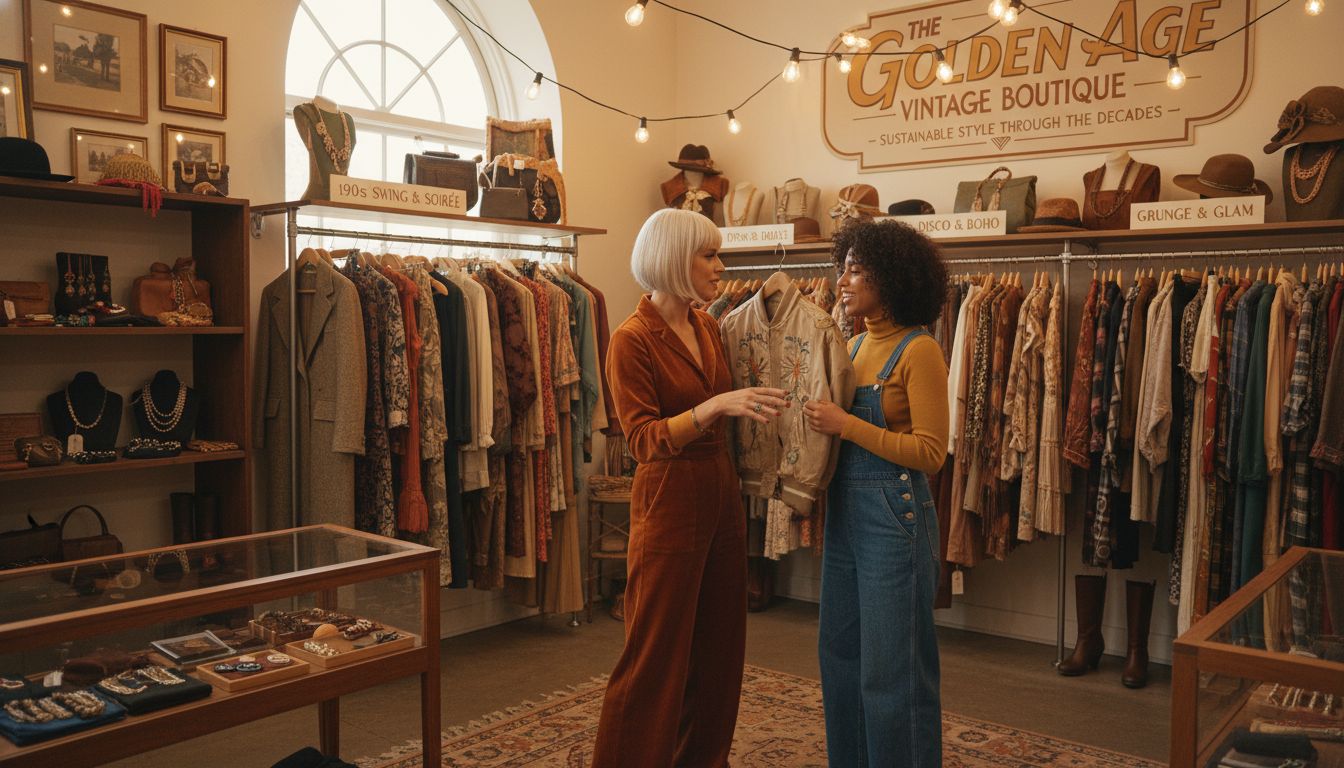Why Choose Vintage Clothing: Complete Guide
- Emma

- Oct 24
- 7 min read

Did you know that only about 10 percent of donated clothing actually gets resold in local thrift shops? The rest often ends up as waste or gets shipped overseas. Vintage clothing brings more meaning to your wardrobe, connecting you to decades of creative style, detailed craftsmanship, and stories woven into every stitch. Discover how exploring vintage expands your personal style while supporting the environment and celebrating true artistry from fashion’s past.
Table of Contents
Key Takeaways
Point | Details |
Definition of Vintage | Vintage clothing refers to items that are at least twenty years old, embodying design, craftsmanship, and cultural history from specific eras. |
Sustainability Aspect | Choosing vintage fashion promotes environmental sustainability by reducing textile waste and the demand for new clothing production. |
Authenticity Importance | Authentic vintage pieces are original artifacts that capture the unique manufacturing and design qualities of their time, enhancing their value and appeal. |
Distinctions from Modern | Vintage clothing stands out for its superior craftsmanship and historical significance compared to modern mass-produced garments. |
What Vintage Clothing Really Means
Vintage clothing is more than just old garments - it’s a sophisticated celebration of fashion history and cultural heritage. According to Vogue, vintage clothing specifically refers to garments and accessories that are at least twenty years old but less than one hundred years old, typically spanning from the 1920s to the early 2000s. This definition captures the essence of clothing that tells a rich, nuanced story about its era.
Beyond mere age, vintage clothing represents a unique intersection of design, craftsmanship, and historical context. Research from Unicatt Cultural Research Center suggests that vintage is an attribute defining the qualities and value of objects produced in past decades. These pieces aren’t just clothes - they’re tangible artifacts of cultural expression, reflecting the social norms, artistic movements, and technological capabilities of their time.
Key characteristics that distinguish vintage clothing include:
Exceptional craftsmanship often superior to modern mass-produced items
Unique design details reflecting specific historical periods
High-quality materials and construction techniques
Limited availability, making each piece potentially rare and collectible
Ultimately, choosing vintage clothing means embracing individuality, sustainability, and a deeper appreciation for fashion’s evolutionary narrative. Whether you’re a serious collector or a casual enthusiast, understanding vintage clothing types can transform how you perceive fashion as a living, breathing art form.
Types and Eras of Vintage Fashion
Vintage fashion is a vibrant tapestry of styles that capture the essence of different historical periods, each era bringing its unique aesthetic and cultural significance. Stepping Back in Time: Exploring Fashion Eras reveals the fascinating evolution of clothing through the decades, with each period marked by distinctive design elements and social influences.
Take the 1940s, for instance. According to research from vintage fashion historians, this era was defined by the Utility Clothing Scheme in the UK, which emerged during World War II. As documented by vintage fashion experts, clothing during this period focused on utility and simplicity due to fabric shortages, resulting in boxy, shoulder-padded silhouettes that reflected the pragmatic spirit of the time.
The transformation continued into the 1960s, which brought a radical shift in fashion aesthetics. As highlighted by Homes and Antiques, this decade featured bold characteristics:
Vibrant colour blocks in red, orange, and pink
Simple, clean lines in both daytime and evening wear
Extensive use of modern, man-made fabrics
Dramatic departure from previous decades’ more conservative styles
Each vintage era tells a story - from wartime practicality to psychedelic self-expression - offering fashion enthusiasts a chance to wear not just clothing, but living pieces of cultural history.
Sustainability and Environmental Impact
Vintage fashion represents far more than just a stylish choice - it’s a powerful statement of environmental consciousness. By choosing vintage clothing, fashion enthusiasts actively challenge the destructive cycle of fast fashion and its enormous environmental footprint. Understanding the Benefits of Sustainable Fashion highlights how each vintage piece represents a sustainable alternative to mass-produced garments.
The environmental benefits of vintage clothing are profound and multifaceted. When you select a pre-loved garment, you’re essentially preventing additional textile waste, reducing manufacturing demand, and minimizing the carbon emissions associated with creating new clothing. Each vintage item effectively extends the lifecycle of a garment, preventing it from ending up in landfills and supporting a more circular fashion economy.

Key sustainability advantages of choosing vintage include:
Reducing textile waste and landfill contributions
Lowering demand for new clothing production
Minimizing water and energy consumption in manufacturing
Supporting a circular economy model
Preserving unique, high-quality craftsmanship
Moreover, vintage fashion challenges contemporary fast-fashion consumption by emphasizing craftsmanship, durability, and individual expression. By selecting vintage pieces, you’re not just making an ecological choice, but also celebrating clothing as an art form that transcends temporary trends and disposable fashion culture.
Authenticity, Quality, and Condition
Authenticity is the cornerstone of vintage clothing collecting, separating genuine historical pieces from mere imitations. What is Authentic Vintage? Understanding Its Essence reveals that authentic vintage pieces are original garments from past eras, distinctly different from modern reproductions or retro-styled clothing. According to Vogue, these pieces must specifically originate from a previous era, capturing the unique manufacturing techniques and design sensibilities of their time.
Research from the Unicatt Cultural Research Center highlights that authentic vintage goes beyond simple age - it requires meeting specific aesthetic and manufacturing criteria. A truly authentic vintage piece isn’t just old; it’s a rare artifact that reflects the craftsmanship, materials, and design philosophy of its original period. This means examining details like:
Original manufacturing techniques
Period-specific fabric compositions
Distinctive construction methods
Unique design elements characteristic of the era
Preservation of original structural integrity
When assessing vintage clothing’s quality and condition, collectors and enthusiasts must develop a discerning eye. Essential Tips for Buying Vintage: A Complete Guide recommends carefully inspecting each piece for signs of wear, potential restoration needs, and historical accuracy. The true value of vintage clothing lies not just in its age, but in its ability to tell a story - each thread and seam a testament to a moment frozen in textile history.
How Vintage Differs From Modern Clothing
Vintage clothing transcends contemporary fashion by offering a profound connection to historical narratives and craftsmanship that modern mass-produced garments simply cannot replicate. Vintage Trends vs Modern: Complete Style Guide illuminates the fundamental differences between vintage and modern clothing, highlighting how each piece represents more than just a fashion statement - it’s a tangible slice of cultural memory.
Unlike modern clothing produced through rapid, standardized manufacturing processes, vintage garments were meticulously crafted with exceptional attention to detail. The construction techniques, fabric selections, and design philosophies reflect the aesthetic and technical capabilities of their specific historical periods. Modern clothing often prioritizes cost-effectiveness and trend-driven production, whereas vintage pieces were created with an emphasis on durability, individual expression, and superior craftsmanship.
Key distinctions between vintage and modern clothing include:
Here’s a comparison of key differences between vintage and modern clothing:
Feature | Vintage Clothing | Modern Clothing |
Craftsmanship | Hand-stitched Superior techniques | Machine-made Standardised methods |
Materials | High-quality Natural fabrics | Mixed Synthetic blends |
Design | Era-specific Unique details | Trend-driven Mass appeal |
Production Scale | Limited quantities | Large-scale, fast production |
Historical Value | Represents cultural periods | Minimal historical value |
Hand-stitched details versus machine-based mass production
Unique, era-specific design elements
Higher quality fabric compositions
More intricate construction techniques
Individual character and historical significance
As research suggests, vintage clothing acts as a tangible connection to collective memory, allowing contemporary individuals to experience and understand past experiences through the intimate medium of fashion. Each vintage garment tells a story - a narrative woven into its fabric, stitches, and design that modern clothing can rarely match.
Practical Tips for Buying Vintage Safely
Vintage shopping requires a discerning eye and strategic approach to ensure you’re investing in genuine, high-quality pieces. How to Buy Vintage Online: A Step-by-Step Guide offers crucial insights into navigating the complex world of vintage fashion acquisitions. Understanding the nuanced details can mean the difference between securing a timeless treasure and purchasing a disappointing imitation.
When examining potential vintage pieces, pay close attention to specific details that reveal the garment’s authenticity and condition. According to Homes & Antiques, era-specific considerations are critical - for instance, when exploring 1960s fashion, be cautious about pieces with missing stones unless you’re prepared for potential restoration costs. The ‘make-do-and-mend’ culture of past decades means many vintage items might have subtle repairs or adaptations that tell their own fascinating story.
Essential tips for safe vintage shopping include:
Request detailed, high-resolution photographs from multiple angles
Ask about the item’s provenance and previous ownership
Check for original labels and manufacturing tags
Examine fabric composition and potential wear
Understand the seller’s return and authenticity policies
Research typical pricing for similar vintage pieces
Consider potential restoration or cleaning costs
Remember, buying vintage is more than a transaction - it’s an investment in a piece of living history. Each garment carries its own narrative, and your careful selection helps preserve these remarkable textile artifacts for future generations to appreciate and enjoy.
Discover Timeless Style with Authentic Vintage Clothing
If you have been inspired by the rich heritage and sustainability of vintage clothes, why not experience the charm firsthand? Whether you are seeking unique craftsmanship, era-specific designs, or a way to support a circular fashion economy, My Vintage offers a curated collection that brings history to life. Each piece tells a story and embraces individuality far beyond modern mass production.

Explore our carefully selected range of vintage apparel and retro homeware at My Vintage, where quality and authenticity are guaranteed. Dive deeper into the world of vintage fashion by visiting our insightful articles like Understanding Types of Vintage Clothing and get valuable advice from our Tips for Buying Vintage: A Complete Guide. Start your journey today and make a sustainable, timeless choice that reflects your distinct style and respect for the past.
Frequently Asked Questions
What defines vintage clothing?
Vintage clothing refers to garments that are at least twenty years old but less than one hundred years old, capturing specific historical styles and craftsmanship.
How is vintage clothing more sustainable than modern fast fashion?
Choosing vintage clothing helps reduce textile waste, decreases the demand for new garment production, and minimizes the environmental impact associated with creating new clothing, promoting a circular economy.
What are the key characteristics of high-quality vintage clothing?
High-quality vintage clothing often features exceptional craftsmanship, unique design details from specific historical periods, high-quality materials, and construction techniques, making each piece potentially rare.
How can I ensure the authenticity of a vintage garment?
To verify authenticity, check for original manufacturing techniques, era-specific fabric compositions, distinctive construction methods, and signs of wear consistent with the garment’s age, ensuring it meets certain aesthetic and manufacturing criteria.
Recommended








Comments